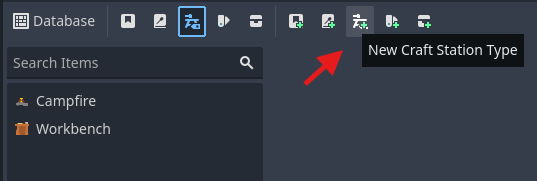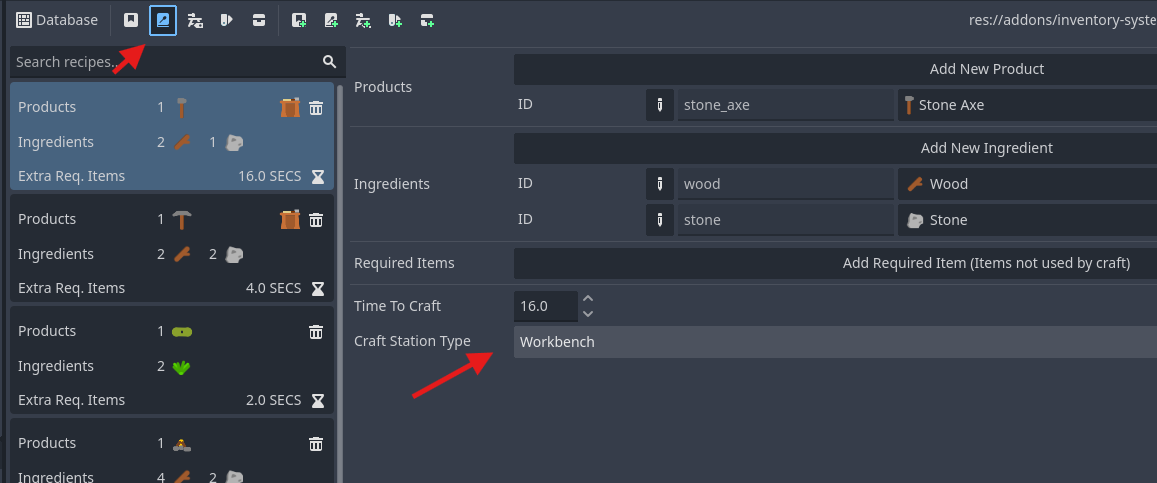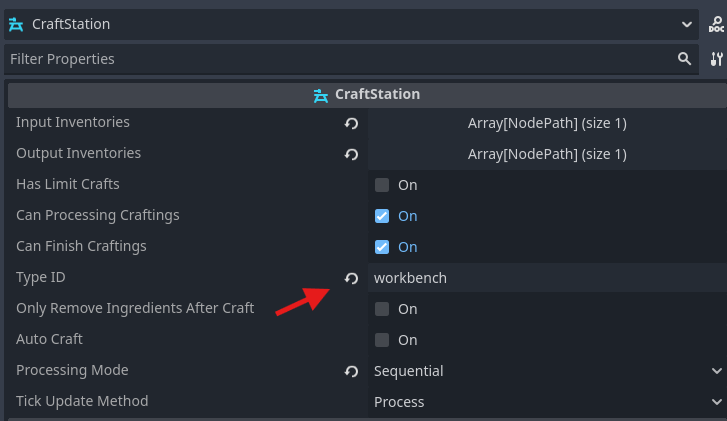CraftStationType
CraftStationType resources define the different types of crafting stations available in your inventory system. They are used to categorize and organize Recipe and CraftStation nodes, ensuring that only compatible recipes can be crafted at specific stations.
CraftStationType Overview
A CraftStationType serves as a filter that connects recipes to their appropriate crafting stations. For example:
A “Furnace” type could be used for smelting recipes
A “Workbench” type could be used for general crafting recipes
An “Alchemy Table” type could be used for potion-making recipes
This system allows you to create diverse crafting mechanics where different types of stations handle different categories of recipes.
Note
If a recipe has no station type assigned, it can only be crafted at craft stations that also have no station type assigned.
Creating CraftStationTypes
CraftStationType resources are created and managed through the InventoryDatabase editor:
Open the Database Editor
Open your inventory database resource in the Inspector. The database editor will appear at the top of the editor.
Navigate to CraftStationTypes
In the database editor, locate the “CraftStationTypes” section.

Add New CraftStationType
Click the “+” button to create a new craft station type. A new entry will appear in the list.

Configure Properties
Set the following properties for your craft station type:
ID: A unique identifier for the station type
Name: A human-readable name for the station type
Icon: An optional icon representing the station type

CraftStationType Properties
ID
The ID is a unique string identifier for the craft station type. This should be:
Unique across all craft station types in your database
Descriptive and consistent (e.g., “furnace”, “workbench”, “alchemy_table”)
Follow naming conventions for easy reference
Example IDs:
- "furnace"
- "workbench"
- "alchemy_table"
- "cooking_pot"
Name
The name is a human-readable label for the craft station type. This is typically used in user interfaces and should be:
Clear and descriptive
Localized if supporting multiple languages
Consistent with your game’s terminology
Example Names: - “Furnace” - “Crafting Workbench” - “Alchemy Table” - “Cooking Pot”
Icon
An optional Texture2D that represents the station type visually. This icon can be used in:
User interfaces showing available crafting stations
Recipe displays indicating where they can be crafted
Crafting menus and tutorials
Using CraftStationTypes
Assigning to Recipes
When creating recipes, you can assign a CraftStationType to specify which type of station can craft that recipe:
Open the recipe in the database editor
Set the Station property to your desired CraftStationType
Save the database

Only CraftStation nodes with a matching type will include this recipe in their available recipes.
Assigning to CraftStations
CraftStation nodes use the CraftStationType to filter which recipes they can process:
Select your CraftStation node in the scene
In the Inspector, set the Type property to your desired CraftStationType
The station will automatically load matching recipes when the scene starts

You can assign a CraftStationType to a CraftStation node in code like this:
# Example: Setting station type in code
@onready var craft_station = $CraftStation
func _ready():
# Load a specific station type from the database
var station_type = database.get_craft_station_type_by_id("furnace")
craft_station.type = station_type
Recipe Filtering
The CraftStationType system provides automatic recipe filtering:
Matching Logic: - Recipes with a station type can only be crafted at stations with the same type - Recipes with no station type can only be crafted at stations with no type - Stations automatically populate their valid_recipes based on this filtering
Example Scenario:
Database contains:
- Recipe A: Station Type = "Furnace"
- Recipe B: Station Type = "Workbench"
- Recipe C: Station Type = None
Craft Stations:
- Station 1: Type = "Furnace" → Can craft Recipe A only
- Station 2: Type = "Workbench" → Can craft Recipe B only
- Station 3: Type = None → Can craft Recipe C only
Best Practices
Organization
Create logical station types that match your game’s crafting themes
Use consistent naming conventions across IDs and names
Group related recipes under appropriate station types
Station Type Design
Consider the complexity and specialization of different crafting processes
Balance the number of station types (too many can be overwhelming, too few may be limiting)
Think about progression - basic stations for early game, advanced stations for late game
Integration with Gameplay
Use station types to gate progression (advanced recipes require advanced stations)
Consider resource requirements for different station types
Plan how players will obtain or build different types of crafting stations
Tip
Start with a few basic station types and expand as your game’s crafting system grows more complex.
Examples
Basic Setup
Here’s an example of a simple crafting system with three station types:
CraftStationTypes:
1. ID: "workbench", Name: "Crafting Workbench"
- Basic tool and item crafting
2. ID: "furnace", Name: "Furnace"
- Smelting and cooking recipes
3. ID: "alchemy", Name: "Alchemy Table"
- Potion and enchantment recipes
Advanced Setup
For more complex games, you might have specialized station types:
CraftStationTypes:
1. ID: "basic_workbench", Name: "Basic Workbench"
2. ID: "advanced_workbench", Name: "Advanced Workbench"
3. ID: "stone_furnace", Name: "Stone Furnace"
4. ID: "blast_furnace", Name: "Blast Furnace"
5. ID: "alchemy_table", Name: "Alchemy Table"
6. ID: "enchanting_table", Name: "Enchanting Table"
See also
Recipes - Learn about creating and configuring recipes
Craft Stations - Learn about using CraftStation nodes
CraftStation Tutorial 1: Resources - Step-by-step tutorial for creating station types